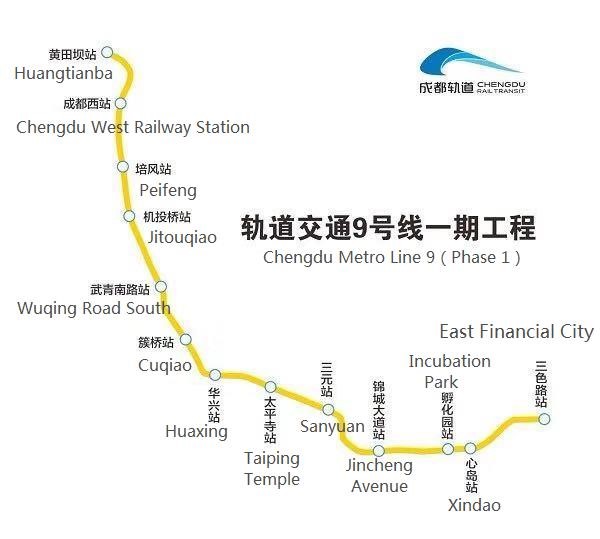J&A (China) & Sepanta Design (UK) Win the Bid for Interior Design of the First Driverless Metro Stations in Southwest China
BACKGROUND
Chengdu, the capital of Sichuan Province in Southwest China, is going to see a revolution in its metro station system by the city’s first fully-automatic driverless metro line opening late next year.
Chengdu Metro Line 9 is a ring line of 22.18km long (in its first phase) and runs from southeast to northwest of the city. The first phase of the line consists of 13 underground stations and is co-built by Chengdu Rail Transit Group Co and China Railway Group. The project’s construction started at the end of 2016, and it will become the first unmanned subway line in west China. It is expected to open operations by the end of 2020.
In 2018, Jiang & Associates Design, acting as the executive interior designers of the project, appointed London-based studio, Sepanta Design, to deliver the schematic interior design of all 13 stations of the first phase of Line 9. The team that were brought together with the support of the Shenzhen-based design management company, Sohovita, won the bid and their proposal will now be going under construction.
THE PROJECT
The interior design of the project started with one key parameter in the designers mind: to adapt the same bold attitude that the construction and operation of the metro line itself was presenting, and to create spaces that would entirely change our level of expectations from what metro stations can offer to their visitors.
“Our main aspiration for the design of these metro stations was for them to do to their users, what the most successful metro stations around the world do to theirs: Provoke Emotions. Metro stations in central Moscow are a great example of that. Chengdu metro stations are not going to be merely points of transit. They are going to be memorable spaces that offer the passengers an artistic and futuristic expression of their culture”, says Reza Esmaeeli of Sepanta Design.
Chengdu Metro Line 9 passes through the birthplace of Sichuan Silk Culture and Sichuan Embroidery Culture and passes through many urban ecological parks. The brief that was prepared by Jiang & Associates requested Sepanta to show the culture and artistry of Sichuan silk and Embroidery, and the design needed to reflect the city’s vitality and creativity.
THE INTERIOR DESIGN
The 13 stations were divided into two categories. Four stations of Incubation Park, Jincheng Avenue, Cuqiao and Jitouqiao were selected as four Featured Stations that would each have a unique concept, reflecting their local environment. The other 9 stations were designed as Standard Stations that would generally follow the same design, but each would have some local elements to them that differentiates it from the others.
Studying the rich culture of Embroidery and Silk Weaving in Chengdu, Sepanta created a formal language for all the stations that is based on an abstract interpretation of the embroidery techniques. The continuous movements of the lines, their interweaving, creation of nodes and pattern generating was reinterpreted and materialized in the 3D space.
Each Featured Station has a different subtheme, based on its location, which is explored and defined by use of its own colour palette, featured zones, and spacial activities and exhibitory materials. Lighting is the key tool in the creation of the desired feeling in all the stations, and is achieved by use of various lighting techniques in each station.
The exhibitory and interactive elements such as Ecology Capsules, Eco Walls, Interactive LCD panels, Holographic Displays, Water Walls, Interactive Projections and Artwork displays remain unique in each station and are designed to create and complement the general storyline of each space.
Incorporation of art by the means of displaying artworks, art projections and ‘local artist experimental zones’ in the featured areas of standard stations aim to promote art in the city in general.
“We are glad for having this opportunity to contribute to the ever-exciting dynamic and historic culture of Chengdu. J&A’s unparalleled experience in design of metro stations and Sohovita’s great support in creating the desired communication line among different parties were all crucial elements of the success of this project. I hope we all get to see this project up and running very soon!”, Sepanta Design.
ABOUT
Headquartered in Shenzhen, China, J&A (Jiang & Associates Design) is one of the biggest interior design firms in Asia. J&A has been honored as “the most influential design team in China” for 10 successive years. Rail transport spaces remain one of the key expertise of the firm.
Sepanta Design is an architectural and interior design studio based in London that focuses on conceptualization and realization of spaces and buildings, which are functional, conceptual and contextual. Sepanta’s experience in designing boutique interior spaces includes residential, hotel and commercial spaces.
SOHOVita is a global design and management platform that connects overseas designers with Chinese architectural projects. SOHOVita’s vision is to make it easier for overseas designers from around the world to work on Chinese projects, regardless of geographical and cultural barriers.


